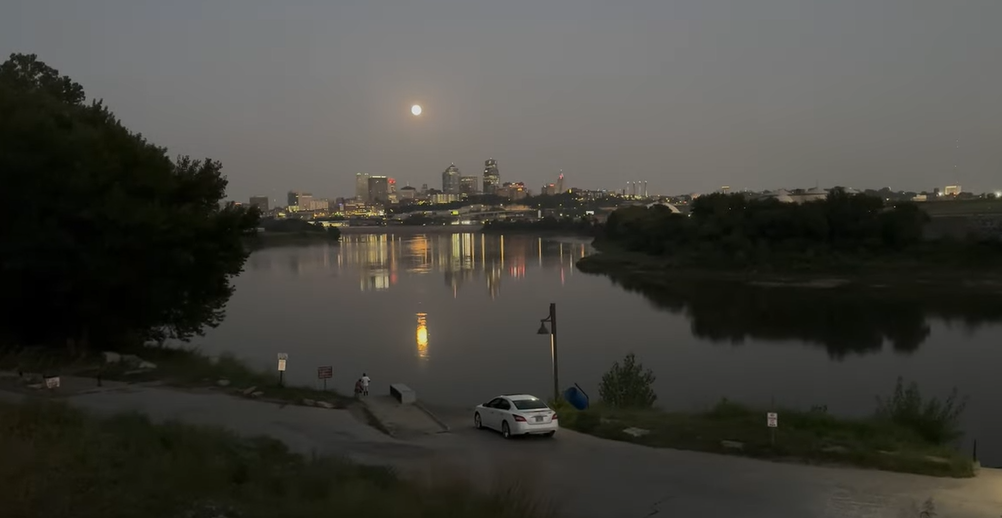There are no eye-catching billboards or tourist slogans at Kaw Point. Rather, it enthralls with something much more timeless—genuine beauty molded by human narratives and river currents. This ten-acre park, which is situated at the poetic confluence of the Kansas and Missouri Rivers, provides more than just a view; it provides perspective. You expect silence when you arrive, and you depart with its memory.
Both city people and tourists have recently rediscover the tranquility that Kaw Point offers. The trails, which meander through native vegetation, provide a particularly serene experience, especially in the morning when the skyline softly illuminates the landscape. In addition to being beautiful, these paths are very adaptable, serving as places for walkers, cyclists, bird watchers, and people just trying to get back in touch.
There is more to the park’s association with the Lewis and Clark Expedition than meets the eye. The renowned explorers stopped here from June 26 to June 28, 1804, resting, mending, recording, and contemplating the strategic value of this verdant riverbank landscape. It feels quietly profound to stand where they once camped today. An incredibly clear window into a period of exploration, adversity, and ambition is offered by the interpretive signs detailing their journey.
Kaw Point Kansas City Overview Table
| Feature | Detail |
|---|---|
| Name | Kaw Point Park |
| Location | 1403 Fairfax Trafficway, Kansas City, KS 66115 |
| Established | Part of Lewis & Clark National Historic Trail |
| Historical Significance | Lewis and Clark camped here June 26–28, 1804 |
| Administered By | National Park Service |
| Area | 10 acres |
| Coordinates | 39.1165°N, 94.6105°W |
| Amenities | Amphitheater, pavilion, wooded trails, river access |
| Open Hours | Daily from 7:00 AM to 10:00 PM |
| Website | www.kawpointpark.org |

The park maintains its surprisingly immersive quality by maintaining the natural character of the area. Even though Kaw Point is in the middle of the city, it still has wooded edges and wildlife. Sometimes deer dart through the trees, and herons move almost scriptedly across the water. It’s simple to forget that the city is still bustling with activity just beyond the riverbanks.
Kaw Point is especially inventive in the way it combines community involvement with subdued naturalism. Built into the landscape and furnished with electricity, the amphitheater has developed into a popular venue for historical reenactments and local performances. Live music fills the outdoor space during the summer, providing visitors with an up-close look at cultural expression without the barriers of ticket booths or walls.
Kaw Point is a welcome departure from Kansas City’s wider cultural offerings. It enhances the Power & Light District and Union Station rather than competing with them. Kaw Point slows the heartbeat and encourages introspection, in contrast to those attractions that throb with urban energy. It’s a necessary pause, not just a counterbalance.
Through strategic alliances, the park has also developed into a resource for education. Native plant life has returned in force thanks to garden initiatives in partnership with the Missouri Prairie Foundation. The award-winning wildflower gardens provide a visual feast for photographers and nature enthusiasts, and they are exceptionally successful at encouraging pollinator activity. The end result is a park that is vibrant in all respects—emotionally, educationally, and ecologically.
The park’s infrastructure and visibility have significantly improved over the last ten years due to community interest in preserving and restoring Kaw Point. Volunteer cleanups and awareness campaigns have greatly decreased the amount of littering that was once an issue. The effects are evident: schools organize field trips, families feel comfortable bringing kids, and lone hikers visit without fear.
Kaw Point has developed into a haven for Kansas City’s musicians, poets, and artists. In an interview with a local newspaper, a violinist called the acoustics of the amphitheater “natural velvet.” A Westport painter described how he comes back seasonally to capture the light across the river’s curve, stating that the scenery appears different every time he paints. People are drawn to this place because of that kind of subtle change.
Kaw Point was a lifeline during the pandemic when indoor areas were closed. While most things stood still, the park’s open trails provided movement, couples enjoyed a picnic at social distance, and musicians played softly to a dispersed audience. It served as a haven and a reminder that history and nature are dependable allies even in times of adversity.
Historians and city planners predict that Kaw Point’s significance will only increase in the years to come. Parks like this will be essential—not supplemental—to how cities define themselves as a result of the increased focus on historical literacy and sustainable urban spaces. A forward-thinking agenda based on respect includes the promotion of heritage trails, the preservation of the riverfront, and the inclusion of multicultural events.
Kaw Point’s sense of equilibrium between introspection and activity, the past and the present, is remarkably resilient. The attraction of this park is based on something constant, in contrast to many public areas that need to be constantly reinvented to remain engaging. It asks you to show up just the way you are, with no expectations other than to be there. That is especially advantageous in a culture that is fixated on productivity.

